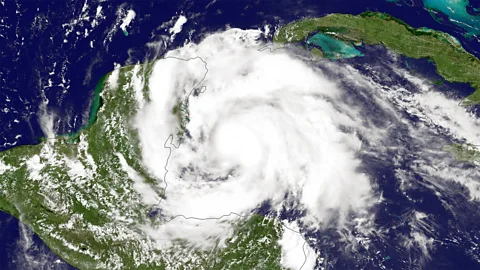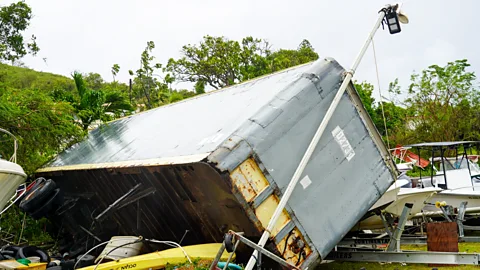Why category 1 hurricanes can be as damaging as the strongest storms
 Getty Images
Getty ImagesDon't be lured into a false sense of security by a category one hurricane – storm surges and flooding mean they can still be incredibly dangerous.
As Hurricane Ernesto – classed a category one – left 40% of Puerto Rico without power and caused flash flooding, scientists are cautioning that low-ranked hurricanes can be just as damaging as category five storms.
Hurricanes are ranked from one to five on the Saffir-Simpson scale, with five being the most intense. The scale was developed back in the 1970s by a wind engineer and a meteorologist. Hurricanes are ranked by their sustained wind speed, but the scale does not take into account other impacts, such as storm surge and rainfall. Hurricanes of all sizes can bring both of these in abundance.
"Focusing too much on hurricane categories can be misleading," says Craig Fugate, former director of the Federal Emergency Management Agency (Fema) and now a crisis response consultant. "While a category five hurricane's winds are undoubtedly destructive, the real danger can lie in the storm's other characteristics," he says. "There is a significant danger of people underestimating the threat of a category one hurricane because of its lower category. The focus on wind speed can lead to a false sense of security."
 Getty Images
Getty ImagesCategory one hurricanes, such as Ernesto, can cause deadly storm surges, catastrophic flooding, and tornadoes. This can lead to infrastructure damage such as power outages, road closures and water contamination – which can have severe, lasting impacts. In fact, the greatest threat to life comes from storm surges, which are caused by water from the ocean being pushed towards the shore by the hurricane's wind force. Water levels can increase by at least 30ft (9.1m). One study found that 49% of hurricane-related deaths in the US were caused by storm surge, 27% were caused by flooding from heavy rain, while just 8% were caused by wind.
"Most damages are from water not wind," says Michael Wehner, a senior scientist at the Lawrence Berkeley National Laboratory who specialises in the changing behaviour of extreme weather events. "The issue is that the [Saffir-Simpson] scale is simply a measurement of the highest wind speed at any point in the storm."
There are also concerns over the public safety aspect of categorising hurricanes by wind speed. Category three storms and above are considered by the National Weather Service as "major" hurricanes, meaning that the public might perceive lesser categories as nothing to worry about.
What is more relevant, Wehner says, is the size of the storm, rather than the wind speed. Category one hurricanes can bring devastating damage even if their windspeed remains under 95mph (153kmph).
Hurricane Debby, a category one, killed five people, while early estimates put the losses between $12.3bn and $28bn (£9.5-22bn). Hurricane Sandy, also classed a category one, is ranked as the fifth costliest hurricane to hit the US, causing $88.5bn (£68.2bn) in damages.
Hurricane Katrina, which killed more than 1,800 people, made landfall in Louisiana as a category three storm, after weakening from a category five at sea. The storm brought surge flooding of 25-28ft (7.6-8.5m) above normal tides in Mississippi, and 10-20ft (3-6m) in south-east Louisiana. Katrina is a "grim reminder" that storm surges pose the greatest potential cause for large loss of life in a single hurricane, a tropical cyclone report by the National Hurricane Center (NHC) concluded in 2005.
 Getty Images
Getty Images"Category one hurricanes can still cause considerable damage to the local communities, especially for the people who live in the flood zones and/or mobile homes," says Xilei Zhao, a data analyst at University of Florida specialising in evacuation behaviour modelling for hurricanes. "The residents should pay close attention to the local officials regarding the evacuation orders, which could be issued for category one hurricanes," Zhao adds.
Improvements in storm surge messaging could ultimately save lives, Jeane Camelo and Talea Mayo, authors of a study on the impacts of the Saffir-Simpson scale on storm surge communication to the public, found. They also noted that climate change would significantly increase the storm surge hazard in coastal regions. That, coupled with more people moving to the coast, puts an increasing number of people at risk of storm surge, heightening the need for improved communication around storm surge risk.
While category one hurricanes are often as damaging as category five hurricanes, Wehner points out they're not as deadly. When category five hurricanes make landfall, the death toll is often high – Typhoon Haiyan hit the Philippines it left more than 6,000 dead.
As the system that's dominated hurricane communications for more than 50 years, the Saffir-Simpson scale has one big benefit: it's an instantly recognisable measure for a storm's strength. But, as Wehner says: "The public needs to know that the Saffir-Simpson scale is not the whole story."
--
For essential climate news and hopeful developments to your inbox, sign up to the Future Earth newsletter, while The Essential List delivers a handpicked selection of features and insights twice a week.
